Please Take Note: This is a review of the final game, but it might change slightly based on the success of the Kickstarter campaign. The game is being reviewed on the components and the rules provided with the understanding that “what you see is not what you might get” when the game is published. If you like what you read and want to learn more, we encourage you to visit the Kickstarter campaign. Now that we have all that disclaimer junk out of the way, on with the review.
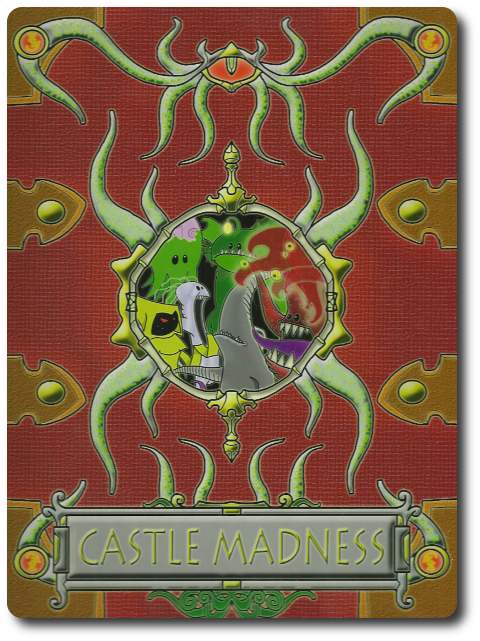
The Basics:
- For ages 14 and up
- For 2 to 4 players
- Approximately 1 hour to complete
Geek Skills:
- Active Listening & Communication
- Counting & Math
- Logical & Critical Decision Making
- Reading
- Strategy & Tactics
- Risk vs. Reward
- Hand/Resource Management
- Worker Placement & Area Control
Learning Curve:
- Child – Moderate
- Adult – Easy
Theme & Narrative:
- Open the gates to your new (although very old) Gods
Endorsements:
- Gamer Geek mixed!
- Parent Geek mixed!
- Child Geek rejected!
Overview
Out of time and space, the Great Old Ones slumber, but also prepare. Their ancient minds stretch through infinity to touch the hearts and minds of men, bending them slowly through the centuries to their cosmic will. They are close to awakening, but there are others in the void with them. The bridge between realities will soon be built, but only one ancient entity can rule.
Castle Madness, designed and self-published by Wim Goossens, will reportedly be comprised of 1 game board, 7 Old One sheets, 40 Action cards (4 sets, 10 per set), 18 Monster cards, 18 Spell cards, 10 Constellation cards, 24 Building cards, 24 Secret Objective cards, 24 Artifact cards, 4 Turn Sequence cards, 1 Madness spinner, 60 Cultist tokens, 20 Upgraded Cultist tokens, 1 Round marker, 4 Faith markers, 8 Special Action tokens, 8 Arcane Glyph tokens, 8 Power tokens, and 1 First Player token. As this is a review of a prepublished game, I cannot comment on the game component quality.
Within Strange Eons…
To set up the game, first place the game board and the Madness spinner in the middle of the playing area and within easy reach of all the players. Place the Round marker on the left-most Moon round position at this time.
Second, Shuffle the Monster cards, the Constellation card, the Artifact cards, and the Spell cards into separate decks, placing each face-down on their designated spot found on the game board.
- The Monster cards represent the different creatures that can be summoned to do the player’s bidding. A player can only have one Monster card in their Grimoire at any given time, but can any number they like in their Library (i.e. deck of personal cards).

- The Constellation cards provide the player a special ability when played.

- The Artifact cards are played in front of the player as soon as they are earned, for a maximum of three in play at a time. Each Artifact card is worth victory points at the end of the game and provides some type of special effect. But there’s a catch. If the player wants to use the power of the Artifact they lose it, discard it after the effect has been resolved.
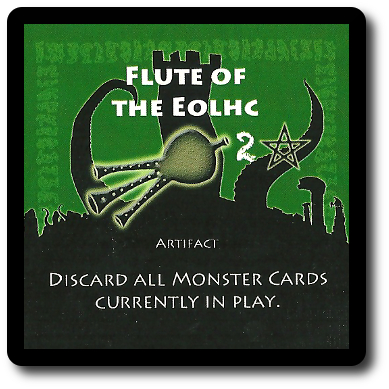
- The Spell cards are like the Constellation cards, wherein they are brought into play and then resolved as a normal action. However, some Spell cards have a secondary secret effect that, once their requirements are fulfilled, are unleashed again.
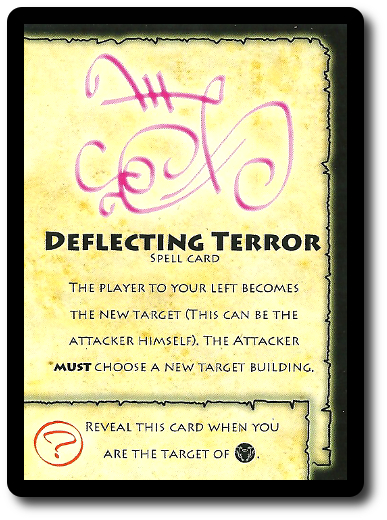
Third, take the Building cards and find the 4 “Ancient Monument” Building cards, setting these cards to one side. Shuffle the remaining Building cards and place them face-down on their designated spot found on the game board. Draw the first three Building cards and place them face-up in a row next to the face-down Building cards.
Fourth, shuffle the Secret Objective cards and set them face-down to one side of the game playing area.
Fifth, take and place 15 Cultist tokens in the “Swirling Madness” space on the game board. Return the remaining Cultist tokens to the game box.
Sixth, have each player select one Old One sheet or randomly deal one to each player. Each player places their Old One sheet in front of them.
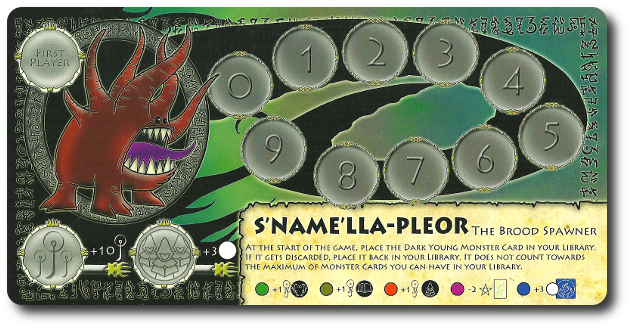
Each player takes one Faith token that is placed on the sheet’s “0” space on the Faith track and Special Action tokens which are placed on the designated space on the sheet, as well. The players also take one Old One token that matches their selected Old One sheet, placing the tokens on the named spaces of each of the three “Tower Path” spaces found on the game board. The Tower Path allows the player to fine-tune their personal strategy, giving the player an advantage with Building cards, Faith, or additional powers. A player can invest in one, two, or all three of the paths as they like.

Seventh, give to each player a Round Sequence card and 10 Action cards. Every player starts with the same actions which are placed in their Library and later used during the game within their Grimoire. Actions include summoning buildings, recruiting more cultists, attacking opponents, spinning the Madness spinner, protecting against attacks, and using ancient arcane glyphs.
Eighth, give each player one “Ancient Monument” Building card, placing it next to their Old One sheet. Then give each player 3 Cultists from the “Swirling Madness” game board space, placing the tokens on their “Ancient Monument” Building card.
Ninth, place the Arcane Glyph tokens, the Power tokens, and the Upgraded Cultist tokens into their own piles and to one side of the game playing area. This is the referred to as the “Reserve”. Upgraded Cultists are just like “normal” Cultists, but provide a higher level of benefit.
Tenth, have each player draw one Secret Objective card. These cards should be kept hidden from opponents until such time they are revealed later in the game.
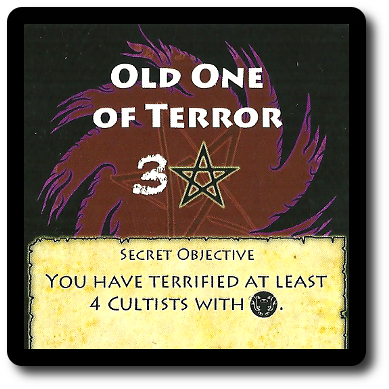
That’s it for game set up. Determine who will go first and give them the First Player token.
Ancient Gods Slumber…
Castle Madness is played in rounds, steps, phases, and turns. A typical game round is summarized here.
Step 1: The Stars Are Right!
If the Round marker is currently occupying a “Star” space, this step is taken. If the marker is on a “Moon” space, this step is ignored.
During a “Star” round, count the number of victory points each player has earned. Victory points are earned from Building cards, Artifact cards, completing Secret Objectives, and Monster cards.
The player with the fewest number of victory points may draw one Constellation card and add it to their Library. If a player is awarded a Constellation card, but there are none available to draw, the player earns two Faith instead, or if the player already has 19 Faith, they earn one Power token.
Step 2: Collect Faith
Each player now counts the total number of Cultists placed on their Building cards. Players earn one Faith per Cultist. If the total number of Faith provided is greater than nine, the token is flipped over to the “10+” side. The maximum number of Faith points a player can have is 19.
Players can have a maximum of 3 Building cards at a time, including their initial “Ancient Monument” Building card. Each Building card will list the number of Cultists that can occupy it (presumably for fire code reasons), its cost, and the number of victory points it’s worth during scoring rounds and at the end of the game. Most Building cards will also have a special ability. Replacing Building cards is possible, but doing so discards the old to make way for the new. When replacing Building cards, all the Cultists in the old building rush to the new one. Any that cannot fit are sent to the Swirling Madness.
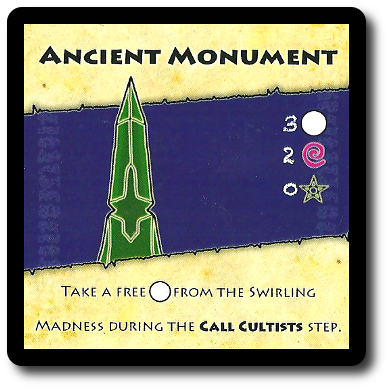
Cultists used to resolve other cards are not counted during this step unless they are being used to by certain Action cards. Cultists that are currently “Terrified” do not provide any Faith points, either.
Step 3: Cancel Terror
Any Cultists that are currently “Terrified” are now released from their said terror.
Step 4: Call Cultists
Each player may now take all their Cultists used to resolve actions and place them back on their Building cards. Any Cultist that cannot be placed are instead added to the “Swirling Madness” space found on the game board. Players can, if they so choose, swap the position of their Cultists at this time, moving them to different Building cards.
Step 5: Refill Library
All previously placed and resolved Action cards from the last round are now collected and placed back into the player’s Library.
Step 6: Create Grimoire
This step challenges the players to think ahead, considering their actions during the next round. This is done by each player creating their “Grimoire”. A player’s Grimoire will be comprised of one or more Action cards or other cards in their Library. The selected cards are placed face-down in a pile in front of the player. Players should also keep in mind that some cards require the player to pay Faith points in order to use them.
Players should stack their Grimoire in the order in which they want the cards resolved, with the first cards resolved starting from the top and moving down. Any cards not in the player’s Grimoire stay in the player’s Library and will not be resolved during this round.
Step 7: Old Ones Phase
Starting with the first player, each player reveals their top-most card of their Grimoire. All cards are revealed at the same time. The order in which the cards are resolved might change due to card abilities.
Any Faith points that need to be paid are subtracted from the player’s Faith track found on their Old One sheet. If the player cannot pay the Faith cost, the card is not resolved. The Madness spinner is used when called for.
The Madness spinner randomized the amount of madness that a player can possibly be plagued with, but madness is also a gateway to power. Instead of “rolling” the dice (so to speak), the player are taking a chance and spinning to determine what they might get that is beneficial and what is not.

All revealed and resolved cards are placed in front of the player, face-up, and in a row unless the cards explicitly states it should be resolved and then discarded.
This continues until all the cards in the players’ Grimoires are resolved. Players without any cards in their Grimoire are skipped, but are still affected by any cards that come into play.
When all the cards have been played, discard all resolved Constellation, Spell, and Monster cards still in play.
Step 8: End Phase
Each player may now complete the following actions in the sequential steps listed here.
- Each player gets a chance to buy one Secret Objective card (no more than three active Secret Objective cards can be in play at a time by the player in most cases).
- Pass the First Player token to the next player in turn order sequence.
- All Faith points not spent are lost and every player resets their Faith point tracker to “0”.
- The Round marker is advanced to the next round.
Dreaming of the End of the World…
After the end of the eighth and final round, the game comes to an end. Final victory points are now calculated.
- Every 2 Cultists gives the player +1 victory point
- Every Upgraded Cultist gives the player +1 victory point
- Every Monster card in the player’s library (excluding those earned via their Old One) gives the player +1 victory point
- Every completed Secret Quest card gives the player +1 victory point
- Additional points earned for Building cards, Artifact cards, Monster cards, and position on the Tower Path
The player with the most points wins the game and gets to devour the Earth. Ties are awarded to the player who has the most Cultists.
To learn more about Castle Madness, visit the game’s Kickstarter campaign.
Final Word
 They Child Geeks are big Cthulhu fans, but never got into the game. According to one Child Geek, “I just think there is too much going on.” There is a lot going on in the game, but never to a point where the Child Geeks felt overwhelmed. Rather, they described their playing experience as “busy” or “a lot of management”. Castle Madness combines several different game mechanics together that all felt like work to the Child Geeks instead of being meaningful and an entertaining means to an end. As one Child Geek put it, “It’s no wonder the Old Gods haven’t eaten everyone yet. Look how long it takes their cultists to do anything!” In the end, all the Child Geeks agreed that they liked the game’s theme, but found the game to be too much effort to enjoy.
They Child Geeks are big Cthulhu fans, but never got into the game. According to one Child Geek, “I just think there is too much going on.” There is a lot going on in the game, but never to a point where the Child Geeks felt overwhelmed. Rather, they described their playing experience as “busy” or “a lot of management”. Castle Madness combines several different game mechanics together that all felt like work to the Child Geeks instead of being meaningful and an entertaining means to an end. As one Child Geek put it, “It’s no wonder the Old Gods haven’t eaten everyone yet. Look how long it takes their cultists to do anything!” In the end, all the Child Geeks agreed that they liked the game’s theme, but found the game to be too much effort to enjoy.
 The Parent Geeks had no problem learning the game and playing, but like the Child Geeks, the casual players found Castle Madness to be a bit top-heavy. According to one Parent Geek, “I don’t feel like this game has been streamlined enough to make it feel as quick as it should be. I’m spending way too much time thinking about my actions and not enough thinking about how I’m going to win the game.” Which is to say, this Parent Geek felt like they were focusing too much on the “small picture” instead of the “big picture.” This was not a shared sentiment across all the Parent Geeks, however. The more experienced players found Castle Madness to be an interesting mix of deck-building and resource management. According to one of these Parent Geek, “The game has got me thinking and planning. I really like that!” When the last Old One was summoned, the Parent Geeks were split, leaving the game with a mixed level of endorsement.
The Parent Geeks had no problem learning the game and playing, but like the Child Geeks, the casual players found Castle Madness to be a bit top-heavy. According to one Parent Geek, “I don’t feel like this game has been streamlined enough to make it feel as quick as it should be. I’m spending way too much time thinking about my actions and not enough thinking about how I’m going to win the game.” Which is to say, this Parent Geek felt like they were focusing too much on the “small picture” instead of the “big picture.” This was not a shared sentiment across all the Parent Geeks, however. The more experienced players found Castle Madness to be an interesting mix of deck-building and resource management. According to one of these Parent Geek, “The game has got me thinking and planning. I really like that!” When the last Old One was summoned, the Parent Geeks were split, leaving the game with a mixed level of endorsement.
 The Gamer Geeks liked a lot of the things going on with the game, but hated (with comedic-like rage) the Madness spinner. According to one Gamer Geek, “Why? I mean, why? I hate these things. They are easy to cheat with and never really spin. I would have preferred the game designer left it out or replaced it with dice.” As for the game, the gaming elitists liked a lot of what was going on. The deck-building and resource management was easy to grasp and to utilize, but the longer the game played, the more the Gamer Geeks saw what they thought to be flaws. According to one such Gamer Geek, “The game is starting to feel less like a well-oiled machine and more of a collection of parts that all appear to be going in the same direction.” The Gamer Geeks eventually came to the conclusion that Castle Madness was on the right track, but was not nearly as well refined as it should be. This left the game in a state of limbo, where some of the Gamer Geeks felt the game was a good time and others felt like the game needed to go back for further design work.
The Gamer Geeks liked a lot of the things going on with the game, but hated (with comedic-like rage) the Madness spinner. According to one Gamer Geek, “Why? I mean, why? I hate these things. They are easy to cheat with and never really spin. I would have preferred the game designer left it out or replaced it with dice.” As for the game, the gaming elitists liked a lot of what was going on. The deck-building and resource management was easy to grasp and to utilize, but the longer the game played, the more the Gamer Geeks saw what they thought to be flaws. According to one such Gamer Geek, “The game is starting to feel less like a well-oiled machine and more of a collection of parts that all appear to be going in the same direction.” The Gamer Geeks eventually came to the conclusion that Castle Madness was on the right track, but was not nearly as well refined as it should be. This left the game in a state of limbo, where some of the Gamer Geeks felt the game was a good time and others felt like the game needed to go back for further design work.
 I was very much in tune with the Gamer Geeks during this review. Castle Madness utilizes many solid and time-honored game mechanics that work wonderfully. I really liked the deck-building aspect, but disliked the actual part of building it for each round. The resource management is also challenging (with the Cultists), but that starts to feel a bit too much like shifting bits rather than managing your strategy. It all felt like too much work at times, causing the game’s level of excitement to dwindle and the game’s overall momentum to quickly drop. Not once, however, did I ever feel like the game was out of my control. Everything I wanted to do was always there in the Action cards, supplemented and further refined by the use of the other cards in my Library.
I was very much in tune with the Gamer Geeks during this review. Castle Madness utilizes many solid and time-honored game mechanics that work wonderfully. I really liked the deck-building aspect, but disliked the actual part of building it for each round. The resource management is also challenging (with the Cultists), but that starts to feel a bit too much like shifting bits rather than managing your strategy. It all felt like too much work at times, causing the game’s level of excitement to dwindle and the game’s overall momentum to quickly drop. Not once, however, did I ever feel like the game was out of my control. Everything I wanted to do was always there in the Action cards, supplemented and further refined by the use of the other cards in my Library.
Some of our players felt like there was too much going on in the game. I disagree. I think the game gives the players a lot of power. It might feel like it’s a bit overwhelming because the learning curve in this game goes from zero to 100. Players are thrown right into it. The actions they make during round 1 set the mood for the next rounds, impacting the entire game. Consider that for a moment. When a player is technically at their weakest is when they start making the most important decision of the game. Making it even more difficult, there isn’t that much game to play, limiting what the players can do to adjust their strategy. Any adjustments they do make are never subtle. You can see an opponent change their tactics as clear as day.
I left the table feeling like I played a game designed by a gaming enthusiast, but the overall gaming experience left me wanting. I think the game needs to be tweaked, some parts are a bit too slow (resolving rounds sometimes feels much longer than it should) and I’m not a fan of the game only being 8 rounds. I would have preferred the endgame was triggered by the players, giving everyone a race-like objective that could be met when it seemed the most tactical and strategic. As it is now, the game feels like it drags you along, sometimes kicking and screaming. That being said, Castle Madness lives up to its name at times. Give it a shot if you enjoy the game’s theme and are looking for a challenging game playing experience.
This is a paid for review of the game’s final prototype. Although our time and focus was financially compensated, our words are our own. We’d need at least 10 million dollars before we started saying what other people wanted. Such is the statuesque and legendary integrity of Father Geek which cannot be bought except by those who own their own private islands and small countries.



